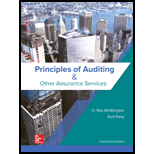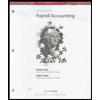
Explain the two sections of the Sarbanes-Oxley Act of 2002.
Explanation of Solution
Explain the two sections of the Sarbanes-Oxley Act of 2002:
Sarbanes-Oxley Act of 2002:
Sarbanes-Oxley Act of 2002 states that public companies should provide a report on their internal control process. This report should be prepared by the management of the company and the auditor. Section 404 of the Sarbanes-Oxley Act of 2002 deals with internal control reporting.
Section 404(a) states that the annual report of the company should include the following two requirements:
- The annual report should include the report which includes the acknowledgment by the management of the company regarding the responsibility for preparing and maintaining enough internal control over the financial records of the company.
- The annual report should provide a review of the effectiveness of the internal
control system of the company. Management must accept their responsibility for the internal control effectiveness, assess the internal control effectiveness and provide the evidence of the assessment.
Section 404(b) states that the auditor of the company should attest and provide a report on the internal control system for the financial reporting of the company. This provision applies to the public companies which have a market capitalization of $75 million or over. Public Company Accounting Oversight Board (PCAOB) has provided conditions for the audit of internal control. PCAOB has issued a standard that describes the integrated audit for the financial statement and the internal control system.
Thus, the Sarbanes-Oxley Act of 2002 has two subsections 404(a) and 404(b).
Want to see more full solutions like this?
Chapter 18 Solutions
EBK PRINCIPLES OF AUDITING & OTHER ASSU
- Please explain the correct approach for solving this financial accounting question.arrow_forwardI need help with this general accounting problem using proper accounting guidelines.arrow_forwardA company paid $36,000 for a 3-year insurance policy on January 1, 2024. The payment was recorded as a prepaid expense. What is the adjusting entry required on December 31, 2024?arrow_forward
- Direct materials used totaled $78,320; direct labor incurred totaled $215,640; manufacturing overhead totaled $298,750; Work in Process Inventory on January 1, 2023, was $157,830; and Work in Process Inventory on December 31, 2023, was $142,940. What is the cost of goods manufactured for the year ended December 31, 2023?arrow_forwardThe constitution margin per unit wasarrow_forwardLumen Products, which uses the high-low method, had total costs of $32,000 at its lowest level of activity when 6,000 units were sold. At its highest level of activity, total costs were $50,000 when 11,000 units were sold. Lumen would estimate fixed costs as _.arrow_forward
- I need help finding the accurate solution to this general accounting problem with valid methods.arrow_forwardPlease explain the solution to this general accounting problem using the correct accounting principles.arrow_forwardPlease provide the correct answer to this general accounting problem using valid calculations.arrow_forward
- Business Its Legal Ethical & Global EnvironmentAccountingISBN:9781305224414Author:JENNINGSPublisher:Cengage






